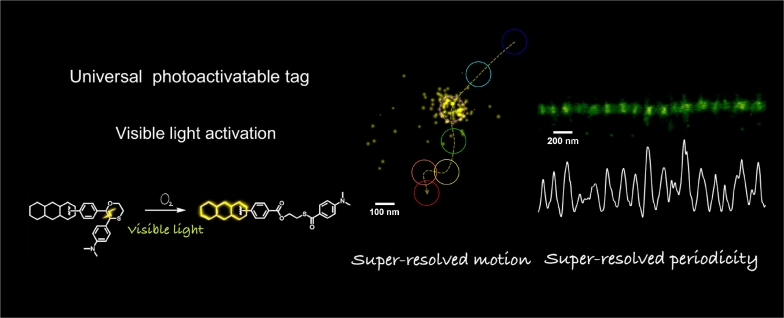Single molecule localization microscopy based on photoactivation is a powerful tool for investigating the ultrastructure of cells. We developed a general strategy for photoactivatable fluorophores, using 2,3-dihydro-1,4-oxathiine group (SO) as a tag to attach to various skeletal structures, including coumarin, BODIPY, rhodamine, and cyanine. The conjugation of SO resulted in a significant loss of fluorescence due to photoinduced electron transfer (PeT). Under the irradiation of excitation light, singlet oxygen generated by the fluorophores converted the SO moiety into its ester derivative, terminated the PeT process, and restored the fluorescence. Single molecule localization imaging was achieved using a dual functional illuminating beam in the visible, acting as both the activating and the exciting source. We successfully applied these photoactivatable probes for time-lapse super-resolution tracking in living cells and super-resolution imaging of microtubule structures in neurons. Single molecule localization microscopy based on photoactivation is a powerful tool for investigating the ultrastructure of cells. We developed a general strategy for photoactivatable fluorophores, using 2,3-dihydro-1,4-oxathiine group (SO) as a tag to attach to various skeletal structures, including coumarin, BODIPY, rhodamine, and cyanine. The conjugation of SO resulted in a significant loss of fluorescence due to photoinduced electron transfer (PeT). Under the irradiation of excitation light, singlet oxygen generated by the fluorophores converted the SO moiety into its ester derivative, terminated the PeT process, and restored the fluorescence. Single molecule localization imaging was achieved using a dual functional illuminating beam in the visible, acting as both the activating and the exciting source. We successfully applied these photoactivatable probes for time-lapse super-resolution tracking in living cells and super-resolution imaging of microtubule structures in neurons.
https://onlinelibrary.wiley.com/doi/10.1002/anie.202211767

